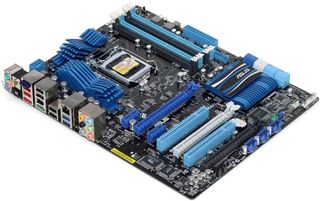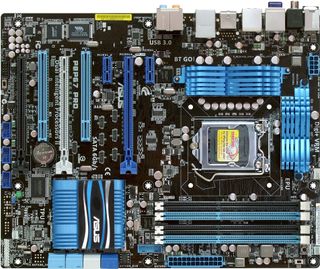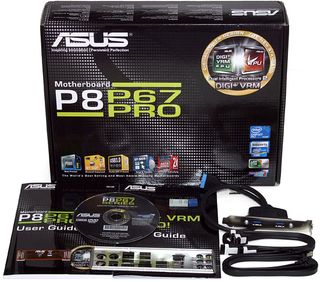P67 Motherboard Roundup: Nine $150-200 Boards
Improved per-clock performance and higher achievable frequencies are sure to put Intel’s latest K-Series CPUs on top of many builders’ whish lists, but they’ll still need a new socket to put it in. We test nine enthusiast-oriented LGA-1155 motherboards.
Asus P8P67 Pro
Asus places its P8P67 Pro above lower-cost rivals with a Bluetooth transceiver—a desktop rarity at any price—plus a separate controller for twin eSATA ports. Intel’s 82579 gigabit Ethernet PHY accesses the chipset’s port directly for improved performance, also freeing up one PCIe port.

One feature that many builders won’t notice until they try to remove the board from a system is that its eight-pin CPU power connector faces latch-side down, easing its disengagement in tight cases and preventing it from being blocked by cables that loop over the top of a motherboard tray. Though the feature is not unique to this board, it still puts it on a list of top candidates for use in our ATX case evaluations.

Asus uses the USB 3.0 front panel first implemented by ASRock and later attributed to Intel, placing it near the center of the P8P67 Pro’s front edge to ease cable management. Other layout features are equally pleasing, with the exception of the front-panel audio connector, which is difficult to reach in the board’s bottom-rear corner.
The term “pleasing” is subjective, since we wouldn’t normally use the four-lane x16-length PCIe slot for a third graphics card. Those that do will find that the card’s cooler pushes tightly against the ends of several front-panel cables, with full card insertion typically requiring enough force to smash the cable ends flat. We’d likely use this slot for a different task.
The other two PCIe x16 slots are spaced three slots apart to allow better airflow to the top card, with a set of automatic switches between them selecting from one x16 to two x8 pathway sets whenever a card is inserted in the middle slot. At the other end of the bandwidth spectrum, two PCI slots are supported by ASMedia’s ASM1083 PCIe to PCI bridge.

One mild curiosity in the P8P67 Pro’s installation kit is its lack of a drive bay panel for the front-panel USB 3.0 ports. Asus is evidently hoping that case manufacturers will catch on soon, as are we. Users who would like to access these ports from a slot plate still get the appropriate adapter.
Stay on the Cutting Edge
Join the experts who read Tom's Hardware for the inside track on enthusiast PC tech news — and have for over 25 years. We'll send breaking news and in-depth reviews of CPUs, GPUs, AI, maker hardware and more straight to your inbox.
-
reprotected I thought that the ECS looked pretty sick, and it did perform alright. But unfortunately, it wasn't the best.Reply -
rantsky You guys rock! Thanks for the review!Reply
I'm just missing benchmarks like SATA/USB speeds etc. Please Tom's get those numbers for us! -
rmse17 Thanks for the prompt review of the boards! I would like to see any differences in quality of audio and networking components. For example, what chipsets are used for Audio in each board, how that affects sound quality. Same thing for network, which chipset is used for networking, and bandwidth benchmarks. If you guys make part 2 to the review, it would be nice to see those features, as I think that would be one more way these boards would differentiate themselves.Reply -
VVV850 Would have been good to know the bios version for the tested motherboards. Sorry if I double posted.Reply -
flabbergasted I'm going for the ASrock because I can use my socket 775 aftermarket cooler with it.Reply -
stasdm Do not see any board worth spending money on.Reply
1. SLI "support". Do not understand why end-user has to pay for mythical SLI "sertification" (all latest Intel chips support SLI by definition) and a SLI bridge coming with the board (at least 75% of end users would never need one). The bridge should come with NVIDIA cards (same as with AMD ones). Also, in x8/x8 PCIe configuration nearly all NVIDIA cards (exept for low-end ones) will loose at least 12% productivity - with top cards that is about $100 spent for nothing (AMD cards would not see that difference). So, If those cards are coming as SLI-"sertified" they have to be, in the worst case, equipped by NVIDIA NF200 chip (though, I would not recommend to by cards with this PCIe v.1.1 bridge). As even NVIDIA GF110 cards really need less than 1GB/s bandwidth (all other NVIDIA and AMD - less than 0.8GB/s)and secondary cards in SLI/CrossFire use no more than 1/4 of that, a normal PCIe v.2.0 switch (costing less than thrown away with x8/x8 SLI money) will nicely support three "Graphics only" x16 slots, fully-functional x8 slot and will provide bandwidth enough to support one PCIe v.2.0 x4 (or 4 x x1) slot(s)/device(s).
2. Do not understand the author euphoria of mass use of Marvell "SATA 6G" chips. The PCIe x1 chip might not be "SATA 6G" by definision, as it woud newer be able to provide more than 470GB/s (which is far from the standard 600GB/s) - so, I'd recommend to denote tham as 3G+ or 6G-. As it is shown in the upper section, there is enough bandwidth for real 6G solution (PCIe x8 LSISAS 2008 or x4 LSISAS 2004). Yes, will be a bit more expensive, but do not see the reason to have a palliative solutions on $200+ mobos.
-
I was hoping that the new Asus Sabertooth P67 would be included. Its new design really is leaving people wondering if the change is as good as they claim.Reply

